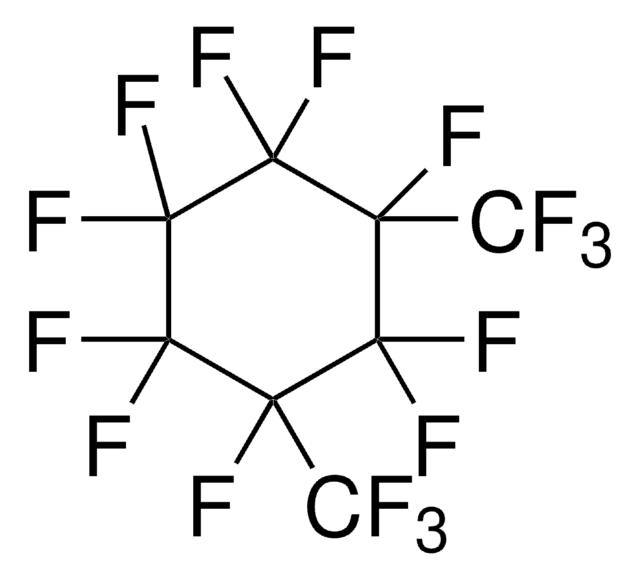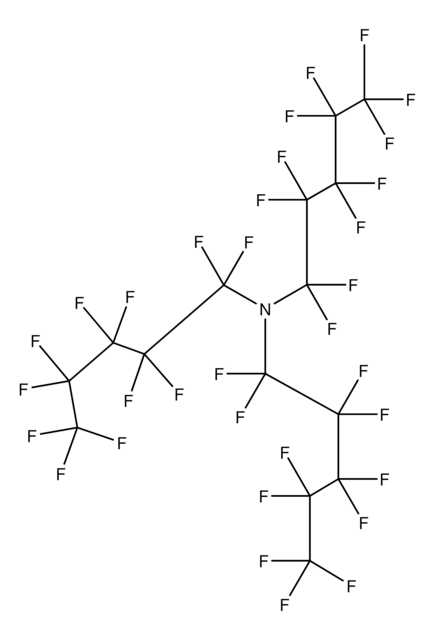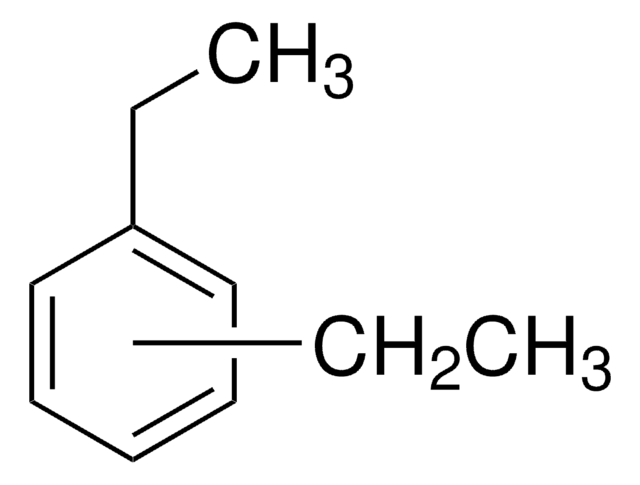302937
Perfluoro(methylcyclohexane)
technical grade, 90%
Synonym(s):
(Trifluoromethyl)undecafluorocyclohexane, Perfluoromethylcyclohexane
Sign Into View Organizational & Contract Pricing
All Photos(1)
About This Item
Linear Formula:
C6F11CF3
CAS Number:
Molecular Weight:
350.05
Beilstein:
1915981
EC Number:
MDL number:
UNSPSC Code:
12352100
PubChem Substance ID:
NACRES:
NA.22
Recommended Products
grade
technical grade
Quality Level
Assay
90%
form
liquid
refractive index
n17/D 1.285 (lit.)
bp
76 °C (lit.)
density
1.787 g/mL at 25 °C (lit.)
functional group
fluoro
SMILES string
FC(F)(F)C1(F)C(F)(F)C(F)(F)C(F)(F)C(F)(F)C1(F)F
InChI
1S/C7F14/c8-1(7(19,20)21)2(9,10)4(13,14)6(17,18)5(15,16)3(1,11)12
InChI key
QIROQPWSJUXOJC-UHFFFAOYSA-N
Looking for similar products? Visit Product Comparison Guide
General description
Mixtures of chloroform and perfluoro(methylcyclohexane) can be used as solvents for "fluorous" biphase reactions. Gas-phase structure of perfluoro(methylcyclohexane) was investigated.
Application
Perfluoro(methylcyclohexane) can be used as:
It can also be used as a solvent to investigate fluorophilicity of a series of hydrocarbon and fluorocarbon-functionalized nicotinic acid esters.
- A reactant to synthesize perfluoro-2-methylcyclohex-1-enolate by photochemical reaction with tetrabutylammonium iodide in water.
- A fluorous solvent to synthesize polynorbornene via ring-opening metathesis polymerization (ROMP) of norbornene using fluorous Grubbs′ second-generation catalyst.
It can also be used as a solvent to investigate fluorophilicity of a series of hydrocarbon and fluorocarbon-functionalized nicotinic acid esters.
Perfluoro(methylcyclohexane) was employed as solvent to investigate fluorophilicity of a series of hydrocarbon and fluorocarbon-functionalized nicotinic acid esters.
Storage Class Code
10 - Combustible liquids
WGK
WGK 3
Flash Point(F)
Not applicable
Flash Point(C)
Not applicable
Personal Protective Equipment
dust mask type N95 (US), Eyeshields, Gloves
Choose from one of the most recent versions:
Already Own This Product?
Find documentation for the products that you have recently purchased in the Document Library.
Customers Also Viewed
Graeme R Kafka et al.
The journal of physical chemistry. A, 114(41), 11022-11026 (2010-09-30)
When refining structures using gas electron diffraction (GED) data, assumptions are often made in order to reduce the number of required geometrical parameters. Where these relate to light, peripheral atoms there is little effect on the refined heavy-atom structure, which
Mei-Jy Jeng et al.
Critical care medicine, 34(4), 1099-1105 (2006-02-18)
To investigate the therapeutic effects of bronchoalveolar lavage (BAL) with either diluted surfactant (SBAL) or perfluorochemical liquid (PBAL), followed by either conventional mechanical ventilation (CMV) or partial liquid ventilation (PLV), on lung injury and proinflammatory cytokine production induced by meconium
Miharu Koshino et al.
Ultrasonics sonochemistry, 54, 250-255 (2019-02-05)
We have developed a new emulsion template method for the synthesis of poly(methylmethacrylate) (PMMA) hollow nanoparticles with different sizes. This synthetic method involves sequential ultrasonic irradiation (20 kHz → 500 kHz → 1.6 MHz → 2.4 MHz → 5.0 MHz) for acoustic emulsification of a water-insoluble fluorous solvent such as perfluoromethylcyclohexane (PFMCH) in
S S Yang et al.
Biology of the neonate, 87(1), 60-65 (2004-10-07)
To test the hypothesis that intrapulmonary perfluorochemical (PFC) liquid may induce hypothermia, and to compare the effects of internal (IC), external (EC), and combined cooling techniques (EC + IC), 14 juvenile rabbits were randomized to EC by a cold blanket
Marco Adamo et al.
Soft matter, 14(10), 1759-1770 (2018-01-23)
The coupling of droplet microfluidics and Small Angle Neutron Scattering (SANS) is demonstrated with a range of model systems: isotopic solvent (H2O/D2O) mixtures, surfactant (sodium dodecyl sulfate, SDS) solutions and colloidal (silica) suspensions. Several droplet carrier phases are evaluated and
Our team of scientists has experience in all areas of research including Life Science, Material Science, Chemical Synthesis, Chromatography, Analytical and many others.
Contact Technical Service









![Poly[4,5-difluoro-2,2-bis(trifluoromethyl)-1,3-dioxole-co-tetrafluoroethylene] dioxole 87 mol %](/deepweb/assets/sigmaaldrich/product/structures/951/320/21327fcd-4960-402d-8ae1-bf2e379cb2e2/640/21327fcd-4960-402d-8ae1-bf2e379cb2e2.png)